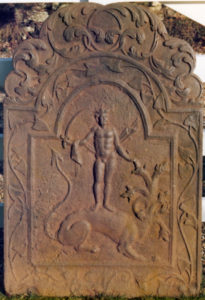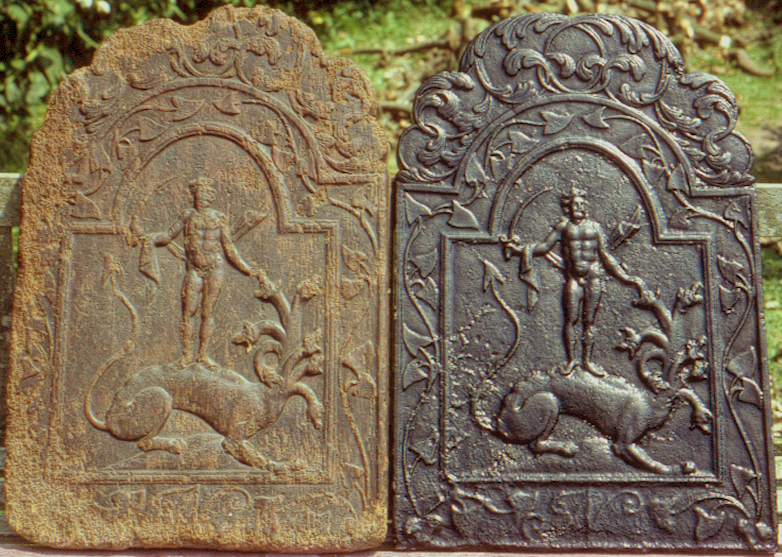
If I remember correctly, my mother told me that, back in the 1950s, she and my father were driving through the village of Hooe, near where we lived in Bexhill, in Sussex, when they spotted an iron fireback amongst some builder’s rubble outside a cottage that was being renovated. They stopped and enquired of the builder what was to happen to the fireback and were told that it was no longer wanted. Asking if they could buy it, the builder let them have it for a couple of pounds. For years it stood in a rusted state in our garage until my father decided to have it cleaned up and painted. When, in the 1970s, they moved house, the fireback was brought indoors and displayed in front of a redundant chimney breast. After my parents died and their house was sold I inherited the fireback, and it is what sparked my interest in these, often enigmatic, domestic relics. What attracts me to this fireback, and I suspect attracted my father in particular, was the strong connection it had with the area where we lived for, almost uniquely, we know without any shadow of a doubt where it was made.

In 1883 passed away William Hobday who, as a ten-year-old boy, 70 years earlier, had been witness to the end of iron smelting in Sussex with the blowing out of Ashburnham Furnace. He had continued to live near where the old furnace had stood and had been custodian of two of the original wooden patterns, or models, that had been used at the furnace to form the moulds from which firebacks had been cast. Such patterns are very rare; I know of only five of British origin that have survived. Crucially, one of the patterns William Hobday kept had been used to make my fireback.

The fireback bears an image of the classical hero Herakles ready to slay the seven-headed Hydra, one of the twelve labours that he had been tasked with by his master, Eurystheus. The particular design on the fireback was probably derived from a book illustration or a set of engravings, but I have not been able to identify it yet. At the bottom of the casting, below the picture, is the monogram TAN, which will have been the initials of the pattern maker, as the same monogram appears on two other firebacks.
Being moulded from a pattern, it was, of course, a simple matter for any number of examples of the fireback to be made, and several castings are known to exist and have been illustrated in books and articles. At an exhibition of the Wealden iron industry that I helped to organise at the Priest House in West Hoathly in the 1980s, I included both the Herakles fireback and its pattern, which I borrowed from the Sussex Archaeological Society. Both of the patterns that William Hobday had kept had been presented to the society by their owner, The Earl of Ashburnham. So, fireback and pattern were reunited for the first time, I suspect, since the one was cast from the other maybe two centuries earlier.
